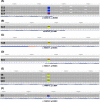Evaluation of the detection of GBA missense mutations and other variants using the Oxford Nanopore MinION
- PMID: 30637984
- PMCID: PMC6418358
- DOI: 10.1002/mgg3.564
Evaluation of the detection of GBA missense mutations and other variants using the Oxford Nanopore MinION
Abstract
Background: Mutations in GBA cause Gaucher disease when biallelic and are strong risk factors for Parkinson's disease when heterozygous. GBA analysis is complicated by the nearby pseudogene. We aimed to design and validate a method for sequencing GBA using long reads.
Methods: We sequenced GBA on the Oxford Nanopore MinION as an 8.9 kb amplicon from 102 individuals, including patients with Parkinson's and Gaucher diseases. We used NanoOK for quality metrics, NGMLR to align data (after comparing with GraphMap), Nanopolish and Sniffles to call variants, and WhatsHap for phasing.
Results: We detected all known missense mutations in these samples, including the common p.N409S (N370S) and p.L483P (L444P) in multiple samples, and nine rarer ones, as well as a splicing and a truncating mutation, and intronic SNPs. We demonstrated the ability to phase mutations, confirm compound heterozygosity, and assign haplotypes. We also detected two known risk variants in some Parkinson's patients. Rare false positives were easily identified and filtered, with the Nanopolish quality score adjusted for the number of reads a very robust discriminator. In two individuals carrying a recombinant allele, we were able to detect and fully define it in one carrier, where it included a 55-base pair deletion, but not in another one, suggesting a limitation of the PCR enrichment method. Missense mutations were detected at the correct zygosity, except for the case where the RecNciI one was missed.
Conclusion: The Oxford Nanopore MinION can detect missense mutations and an exonic deletion in this difficult gene, with the added advantages of phasing and intronic analysis. It can be used as an efficient research tool, but additional work is required to exclude all recombinants.
Keywords: GBA; Gaucher disease; Oxford Nanopore MinION; Parkinson’s disease; long-read sequencing; mutation detection; mutation phasing.
© 2019 The Authors. Molecular Genetics & Genomic Medicine published by Wiley Periodicals, Inc.
Conflict of interest statement
FJS has received honoraria and travel expenses from PacBio. CP is a participant of the Oxford Nanopore Early Access Program, was an invited speaker at the Oxford Nanopore London Calling 2018 meeting, and has received travel expenses from them.
Figures



References
-
- Adler, C. H. , Beach, T. G. , Shill, H. A. , Caviness, J. N. , Driver‐Dunckley, E. , Sabbagh, M. N. , … Hentz, J. G. (2017). GBA mutations in Parkinson disease: Earlier death but similar neuropathological features. European Journal of Neurology, 24(11), 1363–1368. 10.1111/ene.13395 - DOI - PMC - PubMed
-
- Berge‐Seidl, V. , Pihlstrøm, L. , Maple‐Grødem, J. , Forsgren, L. , Linder, J. , Larsen, J. P. , … Toft, M. (2017). The GBA variant E326K is associated with Parkinson’s disease and explains a genome‐wide association signal. Neuroscience Letters, 658, 48–52. 10.1016/j.neulet.2017.08.040 - DOI - PubMed
Publication types
MeSH terms
Substances
Grants and funding
LinkOut - more resources
Full Text Sources
Other Literature Sources
Medical
Miscellaneous

